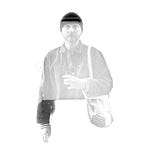“Buck up; Never Say Die” — Michel Hazanavicius’ The Artist
With The Artist French filmmaker Michel Hazanavicius has achieved the seemingly impossible; he made the mainstream press sit up and take notice of the silent cinema. While there has been a contemporary movement in silent film, thanks most notably perhaps to the work of Guy Maddin, one wouldn’t be forgiven for thinking the multiplex days of the silent cinema were numbered. Alas, thanks to Hazanavicius and a couple of note perfect starring performances from Jean Dujardin and Bérénice Bejo the silent movie is back where it belongs, entertaining mass audiences and garnering serious awards attention.
The Artist tells the story of George Valentin, an archetypical “star” of the silent cinema in the vain of a Chaplin or a Keaton, who finds himself outmoded and unwanted when the dawn of sound rises on the Hollywood backlot. As his star falls, that of the delightful Peppy Miller rises, a happenstance made all the more unfortunate by the fact that the pair appear to fall for one another as they pass each other by. In a tale that bounces between the happy-go-lucky beat of Singin’ In The Rain and the harsh of Sunset Boulevard, with the resulting movie being one that might just be the definitive homage to the cinema of the 1920's.
It might sound ropey, and perhaps a tad obvious, but The Artist truly is a celebration of the movies. From a Citizen Kane-riffing breakfast that transplants the first meal of the day firmly in to breakdown territory, to the heavy use of Bernard Herrmann’s ‘Love Theme’ from Alfred Hitchcock’s Vertigo throughout the films second act, it’s a work which oozes respect for the history of the medium. A chief concern of this writer, as something of an ardent fan of the silent period was that Hazanavicius’s film would be planted firmly in the realm of the pastiche, alas that wasn’t to be the case, with the film The Artist pure homage. With a Frenchman firmly behind the helms of The Artist it isn’t simply the Hollywood cinema that is revered; when we first see our hero it is in a guise that riffs on the famous Gallic anti-hero of Fantômas, the character itself the subject of a landmark silent work, in turn entwining the Hollywood of The Artist with the French heritage of the cinema.
The Artist is a surprisingly complex work, or at least it is in terms of thematically. A complicated love affair, which deteriorates via an Wellesian visual motif, stands at the centre of the films first act, the conveyed emotions passed over to the viewer admirably, and wholly successfully. Hazanavicius isn’t afraid of tackling potentially complex subject matter, such as the breakdown of a marriage, minus the luxury of dialogue. The one sequence in which diegetic sound does make an appearance takes the shape of a Kafka-esque nightmare, with the section forming something of a set piece at the same time as portraying the breakdown of an industry. Elsewhere the films most pivotal moment are told in pure silence. No audio accompaniment is necessary, with the complete focus falling upon the visuals.
This diegetic silence of The Artist is actually endemic of the cinema of 2011. The Tree Of Life’s most memorable moments come in the form of its musically accompanied compositions, and Bruno Dumont’s Hors Satan is much the same, albeit minus even the use of music, while perhaps the most memorable scene of 2011, in which Michael Fassbender’s Brendon paces across several NYC blocks in Steve McQueen’s Shame was also absent of the spoken word, as was much of that particular film. Even the protagonist of Rise Of The Planet Of The Apes spoke only 4 words on screen.
While heads might be scratched in terms of defining just where The Artist stems from in terms of a national cinema (Is it a French film, or an American movie? It was produced in the land of the latter, using many American actors and crew members [not to mention that all dialogue is spoken in English], yet it was produced with French money, by a French director and the two main characters are played by French actors). It certainly hinders on that very Gallic respect for the medium, but is a tad more explicit in its celebration than the sort of thing we’re perhaps used to from the French cinema. On the flipside, it feels far too earnest and sincere to be an American tribute to its own heart. Whatever it is, it’s a truly wonderful experience, and one of the defining films of 2011.
A couple of notes on viewing conditions.
This screening of the artist took place in Leeds’ historic Hyde park picture house. Digital print jarred a little, and I’m keen to view a 35mm print of the film in the future (should such a luxury be afforded).
